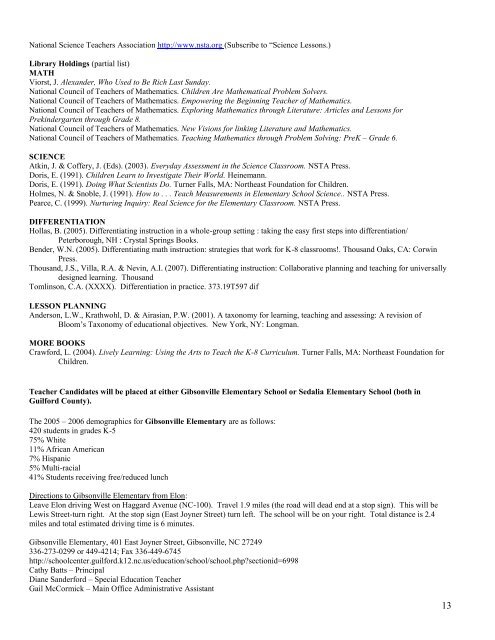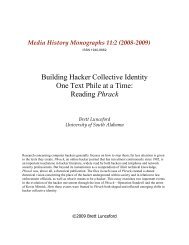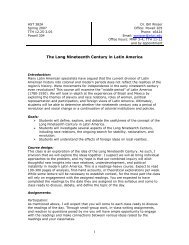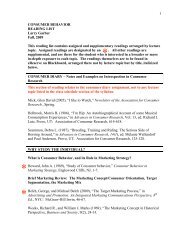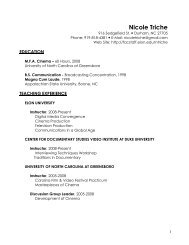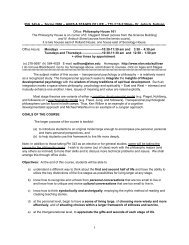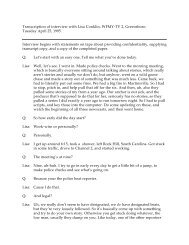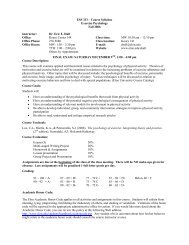1 A grade of “C” or better is required in all Principles courses. Even if ...
1 A grade of “C” or better is required in all Principles courses. Even if ...
1 A grade of “C” or better is required in all Principles courses. Even if ...
You also want an ePaper? Increase the reach of your titles
YUMPU automatically turns print PDFs into web optimized ePapers that Google loves.
National Science Teachers Association http://www.nsta.<strong>or</strong>g (Subscribe to “Science Lessons.)<br />
Library Hold<strong>in</strong>gs (partial l<strong>is</strong>t)<br />
MATH<br />
Vi<strong>or</strong>st, J. Alexander, Who Used to Be Rich Last Sunday.<br />
National Council <strong>of</strong> Teachers <strong>of</strong> Mathematics. Children Are Mathematical Problem Solvers.<br />
National Council <strong>of</strong> Teachers <strong>of</strong> Mathematics. Empower<strong>in</strong>g the Beg<strong>in</strong>n<strong>in</strong>g Teacher <strong>of</strong> Mathematics.<br />
National Council <strong>of</strong> Teachers <strong>of</strong> Mathematics. Expl<strong>or</strong><strong>in</strong>g Mathematics through Literature: Articles and Lessons f<strong>or</strong><br />
Prek<strong>in</strong>dergarten through Grade 8.<br />
National Council <strong>of</strong> Teachers <strong>of</strong> Mathematics. New V<strong>is</strong>ions f<strong>or</strong> l<strong>in</strong>k<strong>in</strong>g Literature and Mathematics.<br />
National Council <strong>of</strong> Teachers <strong>of</strong> Mathematics. Teach<strong>in</strong>g Mathematics through Problem Solv<strong>in</strong>g: PreK – Grade 6.<br />
SCIENCE<br />
Atk<strong>in</strong>, J. & C<strong>of</strong>fery, J. (Eds). (2003). Everyday Assessment <strong>in</strong> the Science Classroom. NSTA Press.<br />
D<strong>or</strong><strong>is</strong>, E. (1991). Children Learn to Investigate Their W<strong>or</strong>ld. He<strong>in</strong>emann.<br />
D<strong>or</strong><strong>is</strong>, E. (1991). Do<strong>in</strong>g What Scient<strong>is</strong>ts Do. Turner F<strong>all</strong>s, MA: N<strong>or</strong>theast Foundation f<strong>or</strong> Children.<br />
Holmes, N. & Snoble, J. (1991). How to . . . Teach Measurements <strong>in</strong> Elementary School Science.. NSTA Press.<br />
Pearce, C. (1999). Nurtur<strong>in</strong>g Inquiry: Real Science f<strong>or</strong> the Elementary Classroom. NSTA Press.<br />
DIFFERENTIATION<br />
Hollas, B. (2005). D<strong>if</strong>ferentiat<strong>in</strong>g <strong>in</strong>struction <strong>in</strong> a whole-group sett<strong>in</strong>g : tak<strong>in</strong>g the easy first steps <strong>in</strong>to d<strong>if</strong>ferentiation/<br />
Peterb<strong>or</strong>ough, NH : Crystal Spr<strong>in</strong>gs Books.<br />
Bender, W.N. (2005). D<strong>if</strong>ferentiat<strong>in</strong>g math <strong>in</strong>struction: strategies that w<strong>or</strong>k f<strong>or</strong> K-8 classrooms!. Thousand Oaks, CA: C<strong>or</strong>w<strong>in</strong><br />
Press.<br />
Thousand, J.S., Villa, R.A. & Nev<strong>in</strong>, A.I. (2007). D<strong>if</strong>ferentiat<strong>in</strong>g <strong>in</strong>struction: Collab<strong>or</strong>ative plann<strong>in</strong>g and teach<strong>in</strong>g f<strong>or</strong> univers<strong>all</strong>y<br />
designed learn<strong>in</strong>g. Thousand<br />
Toml<strong>in</strong>son, C.A. (XXXX). D<strong>if</strong>ferentiation <strong>in</strong> practice. 373.19T597 d<strong>if</strong><br />
LESSON PLANNING<br />
Anderson, L.W., Krathwohl, D. & Airasian, P.W. (2001). A taxonomy f<strong>or</strong> learn<strong>in</strong>g, teach<strong>in</strong>g and assess<strong>in</strong>g: A rev<strong>is</strong>ion <strong>of</strong><br />
Bloom‟s Taxonomy <strong>of</strong> educational objectives. New Y<strong>or</strong>k, NY: Longman.<br />
MORE BOOKS<br />
Crawf<strong>or</strong>d, L. (2004). Lively Learn<strong>in</strong>g: Us<strong>in</strong>g the Arts to Teach the K-8 Curriculum. Turner F<strong>all</strong>s, MA: N<strong>or</strong>theast Foundation f<strong>or</strong><br />
Children.<br />
Teacher Candidates will be placed at either Gibsonville Elementary School <strong>or</strong> Sedalia Elementary School (both <strong>in</strong><br />
Guilf<strong>or</strong>d County).<br />
The 2005 – 2006 demographics f<strong>or</strong> Gibsonville Elementary are as follows:<br />
420 students <strong>in</strong> <strong>grade</strong>s K-5<br />
75% White<br />
11% African American<br />
7% H<strong>is</strong>panic<br />
5% Multi-racial<br />
41% Students receiv<strong>in</strong>g free/reduced lunch<br />
Directions to Gibsonville Elementary from Elon:<br />
Leave Elon driv<strong>in</strong>g West on Haggard Avenue (NC-100). Travel 1.9 miles (the road will dead end at a stop sign). Th<strong>is</strong> will be<br />
Lew<strong>is</strong> Street-turn right. At the stop sign (East Joyner Street) turn left. The school will be on your right. Total d<strong>is</strong>tance <strong>is</strong> 2.4<br />
miles and total estimated driv<strong>in</strong>g time <strong>is</strong> 6 m<strong>in</strong>utes.<br />
Gibsonville Elementary, 401 East Joyner Street, Gibsonville, NC 27249<br />
336-273-0299 <strong>or</strong> 449-4214; Fax 336-449-6745<br />
http://schoolcenter.guilf<strong>or</strong>d.k12.nc.us/education/school/school.phpsectionid=6998<br />
Cathy Batts – Pr<strong>in</strong>cipal<br />
Diane Sanderf<strong>or</strong>d – Special Education Teacher<br />
Gail McC<strong>or</strong>mick – Ma<strong>in</strong> Office Adm<strong>in</strong><strong>is</strong>trative Ass<strong>is</strong>tant<br />
13


